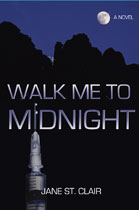El Tiradito
by Jane St. Clair
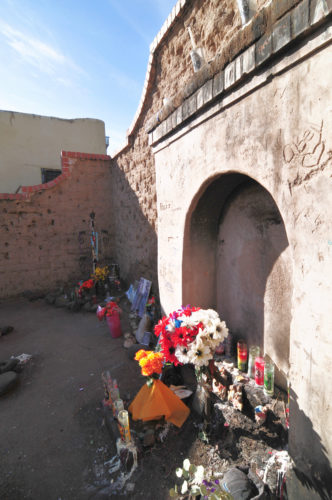
El Tiradito is a wishing place. It is where those who have loved and lost ask for help in mending their broken hearts. It is a place for anyone who still loves someone now lost to them … someone who has left them alone, either physically or emotionally, or someone torn from them through a darkness like addiction.
The legend of El Tiradito promises that if you make your wish and light a candle in this spot, your wish will come true … but only if your candle burns for one whole day.
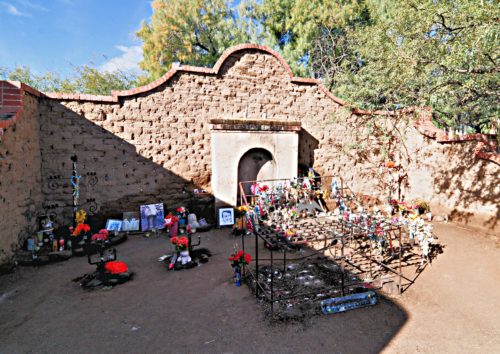
The Story of El Tiradito
One hundred forty years ago, when the West was wild and lawless, a teenaged boy named Juan Oliveras married the daughter of a wealthy sheep rancher. An evil curse on his life began to come true when Juan fell in love with his mother-in-law. His father-in-law caught them together in the family’s mansion in Tucson, went crazy with hatred, and killed Juan. Then he fled to Sonora, Mexico, but he too was murdered – this time by Apache. The two widows left behind took their own lives.
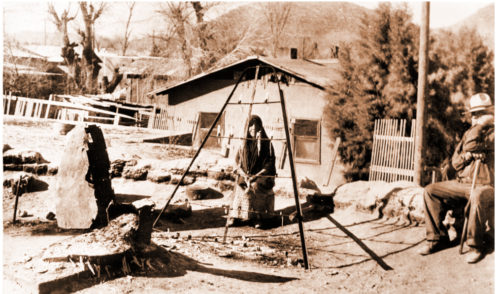
Our story does not end there. The good people of Tucson’s Barrio had to do something to lessen their shock and grief. They called Juan Oliveras by a new name –“El Tiradito–” which means, “Little Castaway,” the one who is shunned and put aside. They built this wishing place so no one would ever forget this tragedy of Shakespearean proportions that affected them all so deeply.
El Tiradito Today
For all this time –over 100 years– the women of the Barrio have maintained El Tiradito’s little grotto. They moved and rebuilt it twice in its long history. Today it’s in an unlikely spot: downtown Tucson, next to office buildings and the convention center.
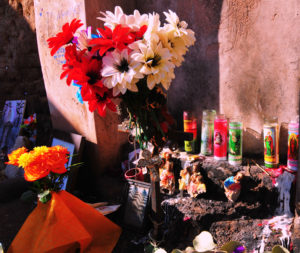
In 1971 builders of the the Butterfield Expressway planned to destroy El Tiradito. The women saved it by putting it on the Register of National Historic Places. They take care of it to this day.
El Tiradito can be ghostly and creepy if you approach it with the wrong energy. You need an open heart that understands the power of forgiveness. To those who believe this spot is primitive and superstitious, I say that you need more magic in your lives. To those who have been in love, you already know fools give you reasons, but wise men never try.






Jane’s short story, “Secrets of Mama Kardashian,” is now available from Wising Up Press in the This book is about Americans who cross class boundaries through immigration, education, marriage, and other means, and how it feels to leave the familiar behind you. To buy a copy of this wonderful book, go to the bookstore at Wising Up Press.
“Mute,” Jane’s short story about a hospice clown who gets confused after she witnesses a murder, is live online in the 97th issue of Image — see Mute by Jane St. Clair. Also, “Disneyland Death,” a story by Jane St. Clair is online in the Spring 2018 PDF issue of Medical Literary Messenger from Virginia Commonwealth University.
Tags: Jane St. Clair · Tucson
Black and White Photography
by Jane St. Clair
I miss black and white photography. It’s been gone since the 1940s, but I don’t care about being old-fashioned and wanting it back.
I like the way black and white photography lends itself to the imagination. It’s all shadows and hollow places, and you have to fill in things like time of day, feelings, and what the picture would look like in color. That means you have to look harder.
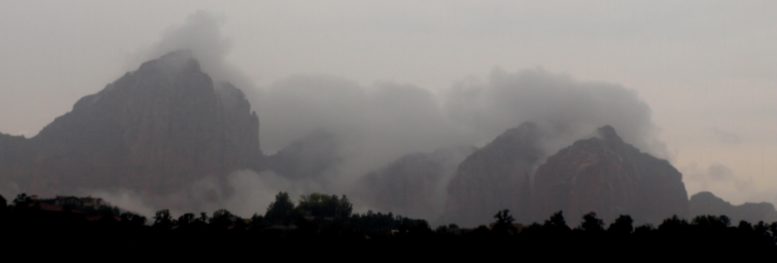
Some pictures are black and white naturally. This shot of a monsoon storm was not touched up at all. The rain and mountain shadows made it black and white naturally.
Other pictures start out with only a little bit of color. Most of today’s photographers avoid those subjects. They want that bam bam bam! look that technicolor gives out.


But to me, this sweet-faced ostrich looks just fine the way he is, sans color, and I also like my picture of the nun going to prayers at San Xavier just the way she is.
Woody Allen is one of the few cinematographers who likes black and white photography. This totally works in his movie “Manhattan,” where he got all kinds of images of New York City that look classic and iconic.

When he used Gershwin’s music in the background, he completely captured the spirit of Manhattan.
I tried to do the same thing in Tucson. I ran into the problem that I could only find one black and white building. And he looks pretty lonely,

…because Tucson is all about light and color.
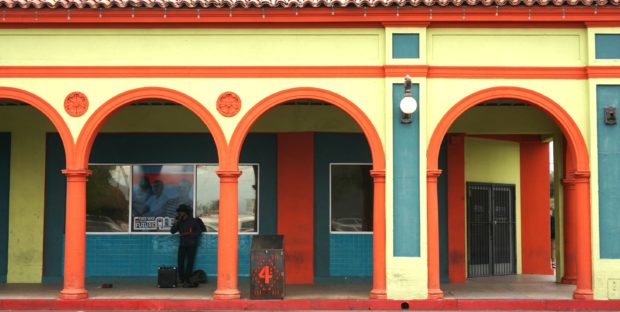
It’s not the same in black and white.
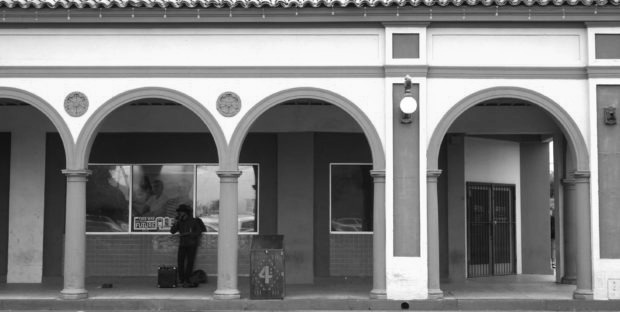
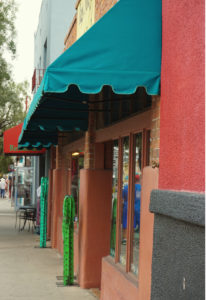
Manhattan Island can be as dark and grainy as Tri-X film.
It rains there sometimes.
Here the sun shines 360 days a year and goes out in glorious sunsets.
Our buildings are wild crayon colors.
If we had background music, it wouldn’t be Gershwin-sophisticated.
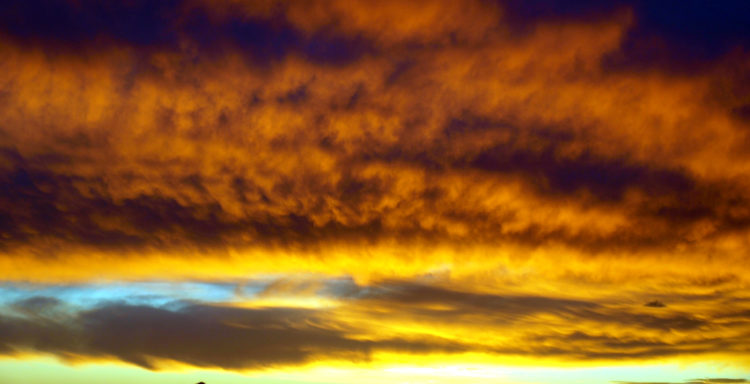
It’d be something younger, happier and peppier, maybe Mariachi songs combined with Native American flutes. The kind of music you hear when the sky lights up in brilliant colors, and suddenly you’re walking when everything around you is luminated. The music of Tucson. The song of the West.








Tucson is celebrating Halloween and the Day of the Dead. For dramatic pictures of our annual parade, see Day of the Dead by Jane St. Clair.
 Jane’s short story, “Secrets of Mama Kardashian,” is now available from Wising Up Press in the This book is about Americans who cross class boundaries through immigration, education, marriage, and other means, and how it feels to leave the familiar behind you. To buy a copy of this wonderful book, go to the bookstore at Wising Up Press.
Jane’s short story, “Secrets of Mama Kardashian,” is now available from Wising Up Press in the This book is about Americans who cross class boundaries through immigration, education, marriage, and other means, and how it feels to leave the familiar behind you. To buy a copy of this wonderful book, go to the bookstore at Wising Up Press.
“Mute,” Jane’s short story about a hospice clown who is confused after she witnesses a murder, is live online in the 97th issue of Image — see Mute by Jane St. Clair. “Disneyland Death,” a story by Jane St. Clair is online in the Spring 2018 PDF issue of Medical Literary Messenger from Virginia Commonwealth University.
Tags: black and white photography
September 28th, 2018 · No Comments
Insects of the Sonoran Desert by Jane St. Clair
Today, children, we’re going  to look at insects of the Sonoran Desert, many of which are totally disgusting or deadly poisonous.
to look at insects of the Sonoran Desert, many of which are totally disgusting or deadly poisonous.
Tarantula Spider
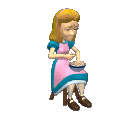 Tarantula spiders are scientifically known as big hairy spiders. In James Bond movies, the bad guy will put a tarantula in James Bond’s bed, and it’ll crawl slowly up his arm before 007 reaches for his gun and blows it away.
Tarantula spiders are scientifically known as big hairy spiders. In James Bond movies, the bad guy will put a tarantula in James Bond’s bed, and it’ll crawl slowly up his arm before 007 reaches for his gun and blows it away. 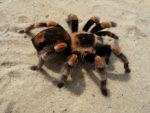 In real life, tarantulas are timid and shy. They’ll run away from you like scared little mice. You”ll only see them when it rains, which is also when Tarantula Hawks go hunting for them.
In real life, tarantulas are timid and shy. They’ll run away from you like scared little mice. You”ll only see them when it rains, which is also when Tarantula Hawks go hunting for them.
Tarantula Hawk
Despite its name, the Tarantula Hawk is neither bird nor spider. It is a mean little insect with a bizarre life cycle that makes you wonder about the wisdom of evolution. Its sting is so painful that 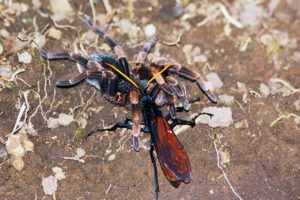 the foremost expert on insects of the Sonoran Desert says when a tarantula hawk bites you, you lose your senses so that no one understands your babbling. The correct thing to do, he advises, is to lie down and start screaming.
the foremost expert on insects of the Sonoran Desert says when a tarantula hawk bites you, you lose your senses so that no one understands your babbling. The correct thing to do, he advises, is to lie down and start screaming.
A female Tarantula Hawk needs to find a big fat tarantula spider in order to survive. Although the Tarantula Spider is gigantic and maybe twenty times bigger than she is, the hawk takes him on. Her sting is so strong that the odds of the spider surviving are 400 to one. She stings him into paralysis, and then lays her eggs into his body. Somehow this is part of nature’s beautiful plan.
Brown Recluse Spider
 The name of this spider brings to mind your old-maid aunt with her brown hair in a bun who teaches piano. However, the brown recluse is a nasty Sonoran Desert insect
The name of this spider brings to mind your old-maid aunt with her brown hair in a bun who teaches piano. However, the brown recluse is a nasty Sonoran Desert insect 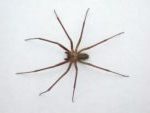 that hides in linen cabinets, and bites you when you grab a towel. His bite is very serious, causing a big red ulcer that needs medical treatment for months and months, and in some cases, until the end of your natural life.
that hides in linen cabinets, and bites you when you grab a towel. His bite is very serious, causing a big red ulcer that needs medical treatment for months and months, and in some cases, until the end of your natural life.
Scorpions
Scorpions are among the most common insects of the Sonoran Desert. The big ones get up to five and a half inches long,  but it’s the little ones that you have to watch out for. They have the nastiest stings. They feel like needle pricks when they get you, but they have this poison that causes nerve damage. Again, part of nature’s perfect plan. One neat thing about scorpions is they glow green in the dark if you shine a black light on them.
but it’s the little ones that you have to watch out for. They have the nastiest stings. They feel like needle pricks when they get you, but they have this poison that causes nerve damage. Again, part of nature’s perfect plan. One neat thing about scorpions is they glow green in the dark if you shine a black light on them.
Giant Red-Headed Centipedes
A giant Red-Headed Centipede can be a foot long, or so claim Texans who are known to tell a tall tale or two. We have gigantic centipedes here in Tucson, and
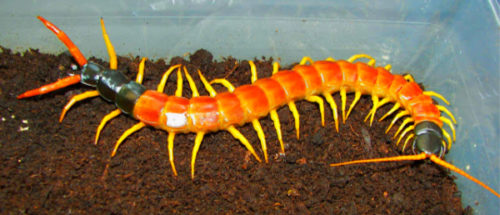
I’d pit ours against theirs any day, although I’ve never seen a 12-inch one. They grow big enough to eat lizards and toads. Sadly, these Giant Red-Headed Centipedes are partly why we redheads have such a bad name. They say a Civil War soldier died when a Giant Redheaded Centipede used his little feet to cover him in bites. However, let’s be careful because this is a story told by Texans.
Killer Bees
 We share our beautiful Sonoran Desert with large swarms of killer bees that look like moving glittery footballs. These bees are aggressive and came to Arizona about ten years ago.
We share our beautiful Sonoran Desert with large swarms of killer bees that look like moving glittery footballs. These bees are aggressive and came to Arizona about ten years ago.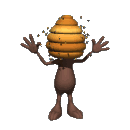 By now they have completely replaced all honey bees, but no one much cares except the dogs, horses and the occasional dumb human that these bees occasionally kill. Again, we Arizonans are okay with various kinds of bees, even though “Killer Bee” has a different ring to it compared to “Honey Bee.” Safety tip: Don’t try to escape killer bees by diving into your swimming pool, as they will wait you out for hours and hours. In that way, they are like grizzlies.
By now they have completely replaced all honey bees, but no one much cares except the dogs, horses and the occasional dumb human that these bees occasionally kill. Again, we Arizonans are okay with various kinds of bees, even though “Killer Bee” has a different ring to it compared to “Honey Bee.” Safety tip: Don’t try to escape killer bees by diving into your swimming pool, as they will wait you out for hours and hours. In that way, they are like grizzlies.





Crossing Class anthology.  Jane’s short story, “Secrets of Mama Kardashian,” is now available from Wising Up Press in the This book is about Americans who cross class boundaries through immigration, education, marriage, and other means, and how it feels to leave the familiar behind you. To buy a copy of this wonderful book, go to the bookstore at Wising Up Press.
Jane’s short story, “Secrets of Mama Kardashian,” is now available from Wising Up Press in the This book is about Americans who cross class boundaries through immigration, education, marriage, and other means, and how it feels to leave the familiar behind you. To buy a copy of this wonderful book, go to the bookstore at Wising Up Press.
“Mute,” Jane’s short story about a hospice clown who is confused after she witnesses a murder, is live online in the 97th issue of Image — see Mute by Jane St. Clair. “Disneyland Death,” a story by Jane St. Clair is online in the Spring 2018 PDF issue of Medical Literary Messenger from Virginia Commonwealth University.
Tags: Tucson Sonoran Desert
Mayer, Az
by Jane St. Clair
The other day I landed up in Mayer, Arizona, for no good reason. It’s smack in the middle of the state, and one of our near-ghost towns that used to be something other than it is now.
In the 1910s, it was a major stagecoach stop between Phoenix and Prescott. In the 1930s it was where you towed your Tin Lizzy when your radiator blew out in the Arizona heat.Today it’s more about historic buildings.

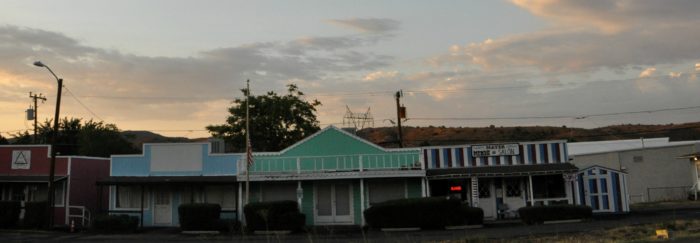
I was lucky in that it was raining and raining hard the day I wandered into Mayer. Just outside of town I got this dramatic hallelujah sky.

Then the subsequent downpour shined up Mayer’s buildings so they looked mysterious and glowing in the reddening twilight. The muddy puddles on the streets had rainbows making little waves as if they were tiny unicorn lakes.
The Wells Fargo stagecoach was stopping at Big Bug Station in Mayer by the 1880s. Twenty years later the town had a saloon, a dance hall, a brothel, a general store and a barber shop. I can imagine cowboys and ranchers resting their horses here in Mayer and frequenting these convenient businesses in the meantime. Some of these shops remain, not quite as ruins but more as remembrances of times past.
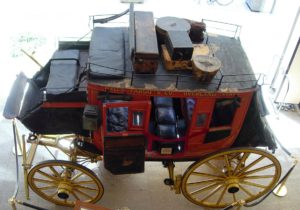 I could picture the Wells Fargo wagon a’coming down the street, and Mayer’s townspeople gathering at Big Bug station – wondering if they got salmon from Seattle, a box of sugar maple or a cross-cut saw —the way we wonder what’s in the Amazon box on the porch.
I could picture the Wells Fargo wagon a’coming down the street, and Mayer’s townspeople gathering at Big Bug station – wondering if they got salmon from Seattle, a box of sugar maple or a cross-cut saw —the way we wonder what’s in the Amazon box on the porch.

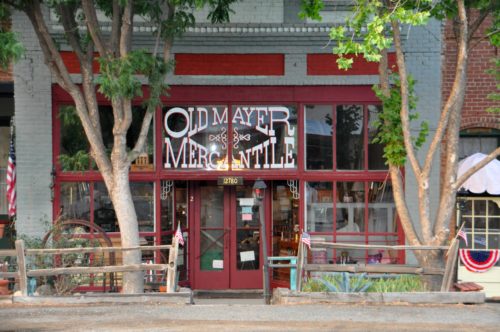
I could also picture the ladies of the town in their long dresses and corsets, living in the dust and heat of the Wild West. Maybe they tried to maintain the standards they brought with them from back East. They’d try to shut down the saloons. They’d insist the town build a big red brick schoolhouse because they wanted to bring refinement and education for the children.
Maybe they tried to maintain the standards they brought with them from back East. They’d try to shut down the saloons. They’d insist the town build a big red brick schoolhouse because they wanted to bring refinement and education for the children.
 I could even picture the Mayer City River Band! It’d march down Main Street with 76 trombones leading the big parade, and 110 coronets close at hand! Tata ta ta!
I could even picture the Mayer City River Band! It’d march down Main Street with 76 trombones leading the big parade, and 110 coronets close at hand! Tata ta ta!
The schoolhouse, Mayer Apartments and the business section of Mayer are on the National Register of Historic Places. But I thought other spots in Mayer were just as cool, like the old brothel near the school, the strange little cemetery on both sides of the road, and the big smokestack that was never even used.
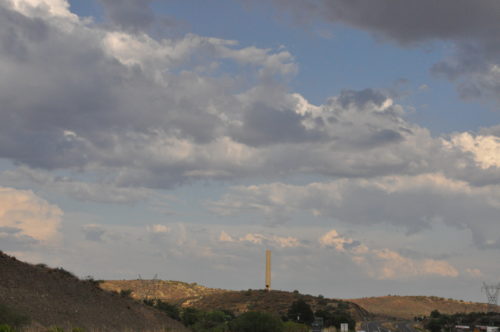
It’s easy to miss Mayer. Most people want to visit Jerome, Arizona, a picturesque old mining city only a few miles away. Tourists also head toward Arcosanti, a nearby experimental desert community designed by Paolo Soleri. These are interesting, but there’s something authentic about Mayer. Something that makes you see the old Wells Fargo wagon itself, and think about the magic of the real West.
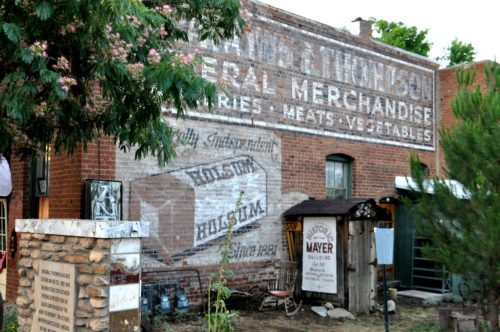
“Mute,” Jane’s short story about a confused hospice clown, is live online in the 97th issue of Image — see Mute by Jane St. Clair. “Disneyland Death,” a story by Jane St. Clair is online in the Spring 2018 PDF issue of Medical Literary Messenger from Virginia Commonwealth University.
Tags: Arizona · Jane St. Clair · Uncategorized
by Jane St. Clair
Tucson, Arizona … A long time ago a mourning dove nested in a Mexican pot in our backyard, but the dog got jealous of my attention to her, overturned the pot and ate her eggs.
So I was very happy that I finally got to make friends with a new mourning dove mama. This time she built a flimsy little stick nest on top of a brick tower just outside my kitchen window. Although she was very close to the house, I was determined not to disturb her. I had to take pictures through a window that has a dirt film, but I figured if I cleaned it, she’d fly away.
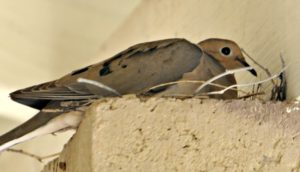 I never really got the phrase “sitting on her eggs” until I watched this mama mourning dove. She sat and sat and sat. For weeks on end.
I never really got the phrase “sitting on her eggs” until I watched this mama mourning dove. She sat and sat and sat. For weeks on end.
She rarely changed position or even moved her strange little head and staring beady eyes. No wonder we get the word “brooding” from bird behavior. This bird sat sitting and staring and brooding for so long she put any brooding hormonal teenager to shame. She could even give famous brooding people like Lord Byron and Dracula a run for their money.
One day I realized that she was sitting on a different kind of chair, one that was more elevated.
And it was true! The eggs had hatched! I could see two little feathered heads.
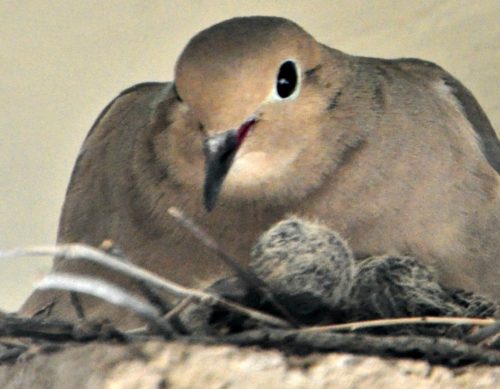
But nothing much changed. She never left the nest, just sat there, keeping them warm, even though the temperature outside was in the 100s. Occasionally I could get a peek at her two babies, born helpless and unable to move on their own. They were not twins, for one was bigger and stronger.
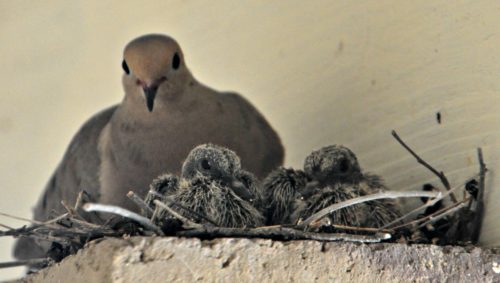
In their dorky dependence on Mama and their fearful little ways, they were adorable. The first few days Mama provided a form of milk, as mourning doves are among the few kinds of birds that can do that.
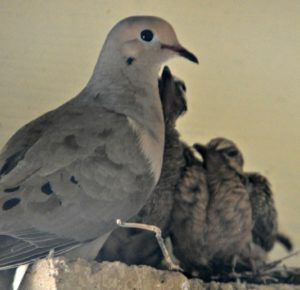 The babies quickly grew into teenagers, and she began to leave them alone and come back with real food.I was amazed at how much work she put into this, especially after the time spent brooding.
The babies quickly grew into teenagers, and she began to leave them alone and come back with real food.I was amazed at how much work she put into this, especially after the time spent brooding.
One morning the bigger baby was no longer in the nest. I slowly opened the front door to check on him, and he was hopping on the ground.
I thought about putting him back up there with his sister, but I decided this little fellow was a daring soul who wanted his own way in life. I named him “the Red Baron” and wished him luck.
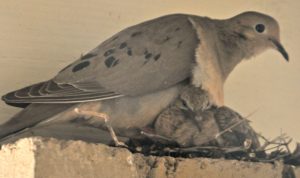
That afternoon his sister tried the same risky maneuver and died in the fall. I cried for her and felt sorry for her faithful selfless mother. It seemed so sad that after all this love and effort, my bird mama had lost a chick.
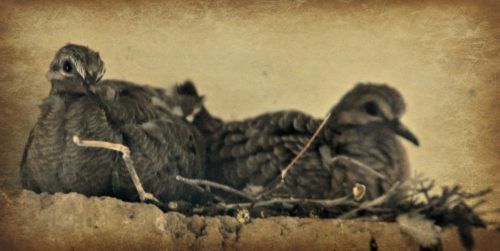
Mama mourning dove left and never came back. I didn’t blame her. I like to think that the Red Baron made it and was somewhere out there, pecking the desert ground in sunlight and flying around cactus in moonlight.
The abandoned nest of sticks reminded me of how much I missed the little family. Then, a week later, I pulled 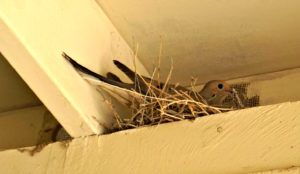 into the car port and there she was. She had built a new nest in a better place, one with a solid roof and walls around it, up there in the rafters of the garage. What’s more, she didn’t have to put up with paparazzi like me taking pictures. It was perfect for her.
into the car port and there she was. She had built a new nest in a better place, one with a solid roof and walls around it, up there in the rafters of the garage. What’s more, she didn’t have to put up with paparazzi like me taking pictures. It was perfect for her.
Godspeed, dove-mama. May all your chicks make it to desert sunlight.





“Disneyland Death,” a story by Jane St. Clair is now available for reading online in the Spring 2018 PDF issue here at Medical Literary Messenger from Virginia Commonwealth University. Negative Capability Press accepted Jane St. Clair’s short story, “The Gerber Secret.” It will appear in the July 2018 issue under the theme of “Family Secrets.”
Tags: Mourning Dove
Tohono Chul Park by Jane St. Clair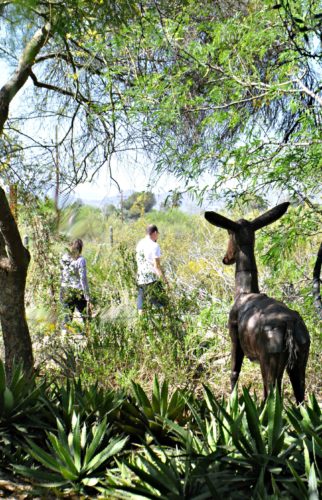
When you think about parks, you think about sports and playgrounds. Tucson’s Tohono Chul Park is nothing about those. Tohono Chul is about gardens and trails.
“Tohono Chul” means “desert corner” in the language of the Tohono O’oham nation, but the park isn’t deserty. It’s more gardens and oasis. And unless you’ve lived in the dry brown dust of a desert, you can’t understand how refreshing it is to feel the green lushness that is Tohono Chul Park.
It’s a big place, almost 50 acres. Once it was a commercial orange grove, and once it was somebody’s house. The house and other properties are now an art gallery, classroom, and a chichi restaurant. The Haunted Bookstore used to be part of Tohono Chul Park, but Amazon ate it up a long time ago.
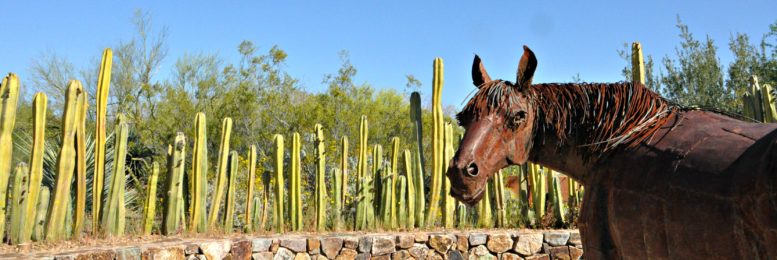
The many gardens of Tohono Chul have names and themes. I like the ones with flowers and water elements the best. The park puts name tags on the plants and flowers that grow there, including over 300 kinds of cactus, and a zillion kinds of Penstemons. The Superb Penstemon, the Showy, Cleveland’s Beardtongue, Whipple’s, Sunset Crater, Gulf Coast, and whatever. Cool.
 The tiny Baja Fairy Duster looks exactly like its name. I’m convinced that tidy fairies grab them up when no one’s looking.
The tiny Baja Fairy Duster looks exactly like its name. I’m convinced that tidy fairies grab them up when no one’s looking.
The Children’s Garden has a whimsical birdhouse and water stream for paper boats. In the Ethnobotanical Garden you can see how the Native Americans farmed and harvested the desert centuries ago.

You’ll want to check out the tortoise enclosure and the dancing men petrographs, and the cactus circle with the horse statue. You can hike on natural desert trails, and if you’re lucky, you’ll see bobcat, coyote and javelina.
I have a favorite cactus out there I always visit because he’s so dorky he makes me smile.
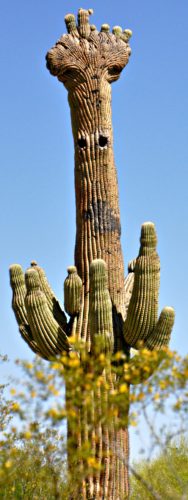 I like to sit on the benches in the gardens and listen to the rustle of the trees and shrubberies accompanied by wind chimes. I like to feel the soft ground under my feet –desert ground is hard, sandy and rocky.
I like to sit on the benches in the gardens and listen to the rustle of the trees and shrubberies accompanied by wind chimes. I like to feel the soft ground under my feet –desert ground is hard, sandy and rocky.
Ralph Waldo Emerson loved gardens. He once said he would rather walk around gardens and nurseries than among the Pyramids. I love his definition of a successful life:
To laugh often and much; to win the respect of intelligent people and the affection of children; To earn the appreciation of honest critics and endure the betrayal of false friends; To appreciate beauty, to find the best in others; To leave the world a bit better, whether by a healthy child, a garden patch, or a redeemed social condition; To know even one life has breathed easier because you have lived. This is to have succeeded.
So there it is. Gardens are that important. To succeed –all you need to do is build a garden. Isn’t it pretty to think so?
To check out the park’s hours and admission charges, go to their website here.

Jane St. Clair’s story, “Disneyland Death,” was accepted for publication by the Medical Literary Journal from Virginia Commonwealth University. Another story “Mute,” about a hospice clown, will appear in Issue 97 of Image, a journal of faith, art and mystery.
Tags: Jane St. Clair · Tohono Chul Park · Tucson
Palo Verdes
by Jane St. Clair
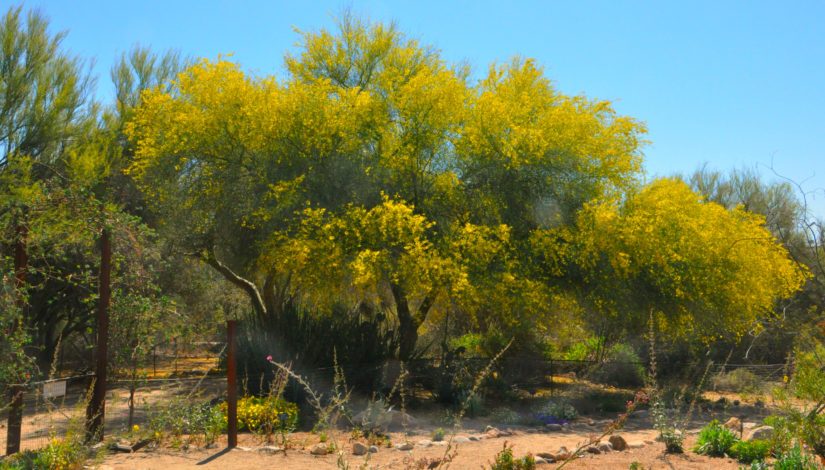
When the Spaniards came to the Southwest, they named these trees “Palo Verdes,” which means “Green Sticks.”
 They called them by that name because they had never seen trees with green bark before.
They called them by that name because they had never seen trees with green bark before.
I wonder what they thought of the Palo Verdes in springtime when their great yellow canopies come to life. I wonder if they too saw millions of tiny yellow flowers light up the desert, and if they watched them flash and twirl against the bright turquoise sky.
Palo Verdes are everywhere in the Sonoran spring. Since the desert is usually a dusty brown along with a zillion shades of pastel greens, this means when the Palo Verde trees bloom, they are the whole show.
The contrast of bright yellow flowers against the bright blue sky can be too much for our human eyes to grasp. No wonder Van Gogh went nuts. Colors can do that to you.

I love the way the little Palo Verde petals get caught in the wind and flutter around. I like the way their petals float and dance in space whenever they are caught in a silvery thread left by a spider. I love the way these trees look in different lights, especially sunset.When the sun backlights Palo Verdes in a certain way, their blossoms look like shining polka dots, like stars dotting the night sky.
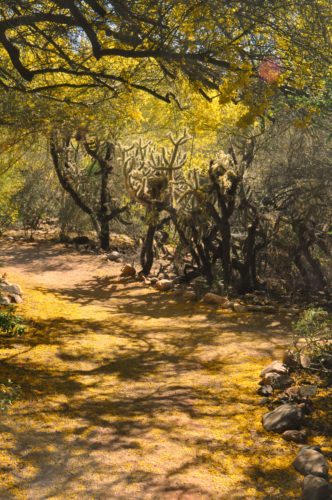 Then –just when you think Palo Verdes could not bring more beauty to the desert– their little petals start to drop. The petals are only the size of your thumbnail, and they’re simple little things, just four crinkly petals arranged in a star. When they are dropping, you walk with a velvet yellow carpet under your feet … When you look up, there’s yellow. Look down, there’s yellow. Yellow everywhere you look!
Then –just when you think Palo Verdes could not bring more beauty to the desert– their little petals start to drop. The petals are only the size of your thumbnail, and they’re simple little things, just four crinkly petals arranged in a star. When they are dropping, you walk with a velvet yellow carpet under your feet … When you look up, there’s yellow. Look down, there’s yellow. Yellow everywhere you look!
Autumn back East, back home, is magnificent with red, brown, yellow and orange colors. Yet the combination of Palo Verde yellow and Arizona turquoise in the Sonoran spring is just as jarring and just as beautiful as a Midwestern fall.
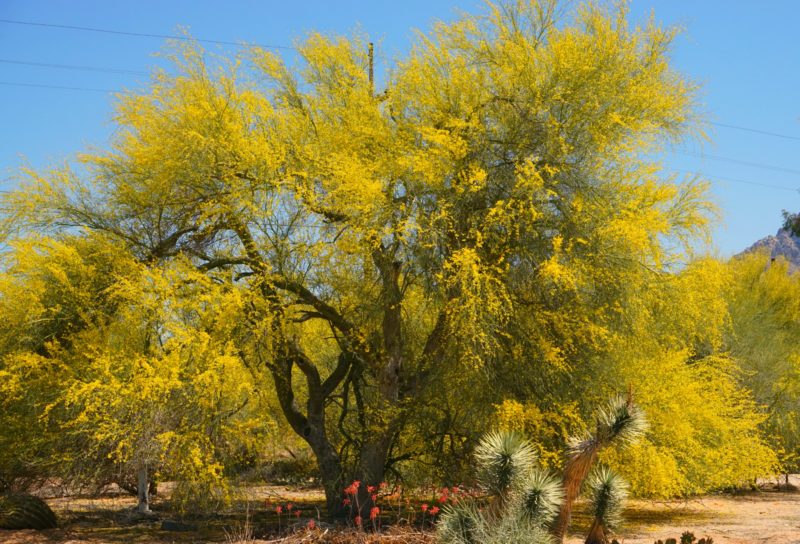
Pablo Picasso once asked the question, “Why do two colors, put one next to the other, sing? Can one really explain this?”
I doubt if you can explain it. I also think it’s unimportant to explain things anyway – especially if you can just let two colors sing.





Wising Up Press accepted Jane St. Clair’s short story, “Secrets of Mama Kardashian,” to be included in a new anthology called Crossing Class: The Invisible Wall. The stories in this book all explore “The great unspeakable” about a country based on the principle that all people are equal.
Tags: Arizona · Jane St. Clair
Fourth Avenue
by Jane St. Clair
Every city or university town has a place like Tucson’s Fourth Avenue.

It’s the groovy neighborhood full of bookstores, coffee houses, and shops where you buy art, marijuana, tattoos, vintage clothing, and tarot readings.
You see people who got left behind there and who are still living in the 1960’s. And you see people who got left completely behind and who are living in stairwells and on park benches. But you’ll also see writers, artists, students, musicians, revolutionaries, and philosopher-kings living there as well.
Someone’s always protesting something on Fourth Avenue.
You’ve got to admire their passion.

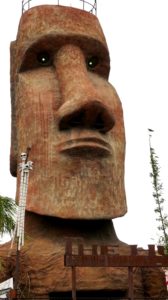 For some reason Fourth Avenue has this big Dairy Queen right in the middle, and a huge Tiki Man on one end of it. Tiki Man has creepy green eyes that stare down at you like Dr. T.J. Eckleberg’s eyes in “Great Gatsby.” What are you smoking, Tiki-Man?
For some reason Fourth Avenue has this big Dairy Queen right in the middle, and a huge Tiki Man on one end of it. Tiki Man has creepy green eyes that stare down at you like Dr. T.J. Eckleberg’s eyes in “Great Gatsby.” What are you smoking, Tiki-Man?
Fourth Avenue has its own trolley, one of the most expensive trains in the country in terms of cost per-foot. The trolley runs less than four miles but cost almost $200 million or about $50 million a mile.
Far out, eh, man?
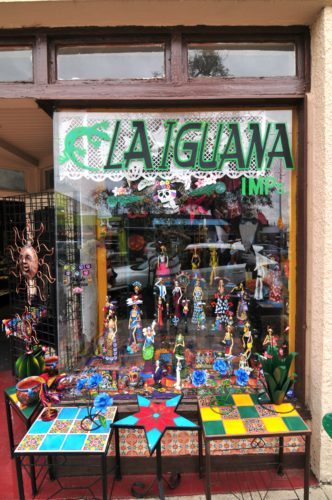
Fourth Avenue is part of the Pie Allen Historic District. The neighborhood looks as if it’s honoring the historic 1960s, but its historic value is in its buildings from the 1880s to 1930s. The district was named after Pie Allen, a prospector. Yes, that is his real name –not Allen Pie. Pie baked pies as well panned for gold.
What you’d like about Fourth Avenue–
–Cool thrift stores and hip restaurants
–A Food Co-op that promotes sustainability
–The arches in the Goodwill Building

–Street musicians and the green cactus piano you can play yourself
–The annual Fourth Avenue Street Fair
–Revolutionary spirit
–Creativity and art everywhere in sight
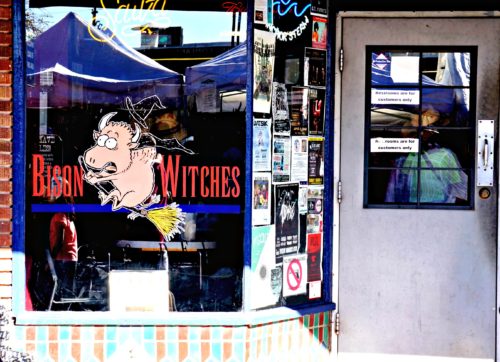
A groovy place, this hippie heaven
Where it’s always the summer of ‘67
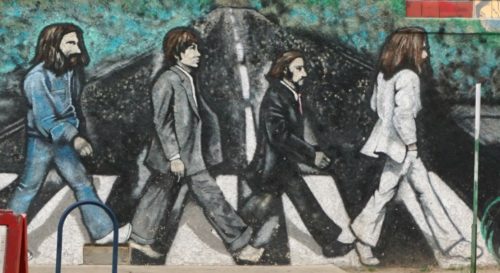
Wising Up Press accepted Jane St. Clair’s short story, “Secrets of Mama Kardashian,” to be included in a new anthology called Crossing Class: The Invisible Wall. The stories in this book all explore “The great unspeakable” about a country based on the principle that all people are equal.
Tags: Jane St. Clair · Tucson
Desert Spaces
by Jane St. Clair
John Masefield wrote, “I must go down to the seas again to the lonely seas and the sky,” but you could say that about longing to go down to the desert again, to the lonely desert and sky. Something in me longs for desert spaces.

I understand that you might picture the desert as a place where things are lacking –a place where there is not enough rain, not enough greenery, not enough animals that look like us. I think the desert is enough just the way it is. I mean that it has enough rain, it has just the right number of plants, and the few animals who live there are happy. The desert is beautiful, perfect and enough just the way it is.
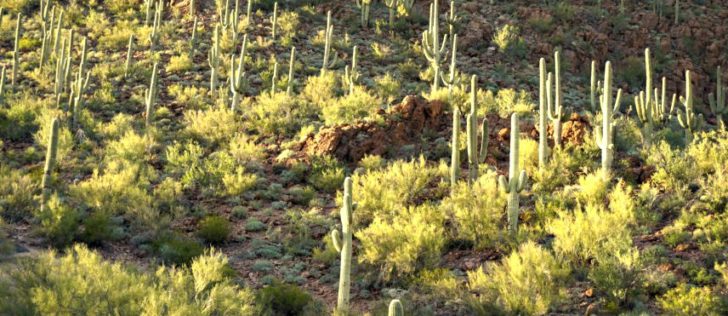
What I like most about the desert are its big blank spaces. You need these spaces to make a desert what it is. In that way the desert is like music. In music the space between the notes is just as important as the notes themselves.
Antoine Saint Exupery, an aviator as well as an author, loved the desert by chance. When his plane crashed in the Sahara, he had an unplanned desert encounter that he later used as the basis of his most famous book, “The Little Prince.”
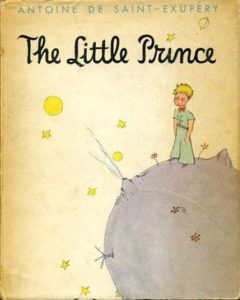
He decided the quality makes the desert so beautiful is mystical and invisible, like love. He wrote, “The stars, the desert — what gives them their beauty is something that is invisible! …. One sees clearly only with the heart. Anything essential is invisible to the eyes.”
“I love the desert,” Antoine Saint Exupery wrote. “You see nothing. You hear nothing. And yet something shines, something sings in that silence…”’ I think he was again talking about the something that is invisible to the eyes. I don’t think he found the peace of the desert to be lonely, because he wrote this in “The Little Prince:”
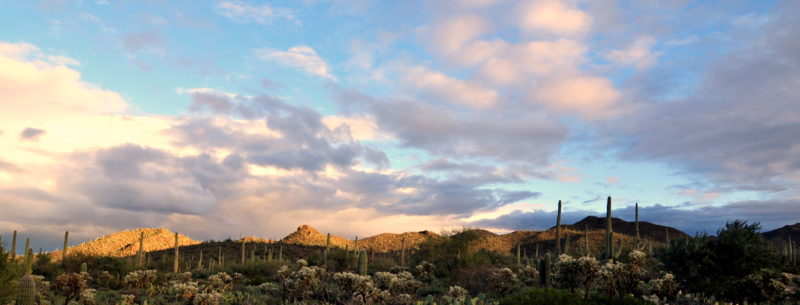
–“Where are the people?” The little prince asked. “It’s a little lonely in the desert.”
–“It’s also lonely with people,” said the snake.
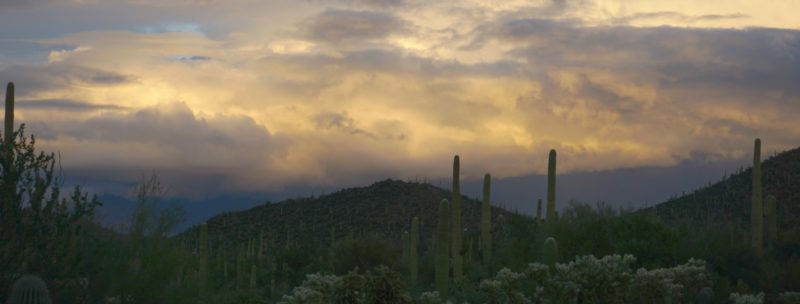
In Algeria, the desert is considered the Garden of Allah. You might think, how strange! A desert is the opposite of a garden. Yet the saying in Algeria is this —The desert is the Garden of Allah where the Lord of the faithful took away all superfluous human and animal life so that there might be one place where He can walk in peace.
Peace to you as well.
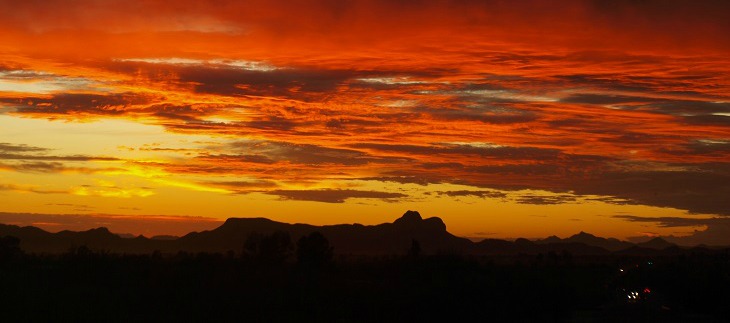


 It really does rain on the Arizona desert. To see how that looks, go to The Desert Smells Like Rain.
It really does rain on the Arizona desert. To see how that looks, go to The Desert Smells Like Rain.
“Mute,” Jane’s short story about a confused hospice clown, will be published in the next issue of Image, a journal of art, faith and mystery.
Tags: Arizona
This here is the true-life factual legend of Pecos Bill, World’s Greatest Cowboy. It’s not just some warmed-over Disney pan of beans.
Pecos Bill was the youngest of 17 children, but even as a little baby, he showed the most potential. He’d do his teething on a Bowie knife, and he’d play with bobcats and rattlesnakes instead of your regular human beings.
he showed the most potential. He’d do his teething on a Bowie knife, and he’d play with bobcats and rattlesnakes instead of your regular human beings.
One day some family moved within 50 miles of baby Billy’s family, which meant the place was too crowded. 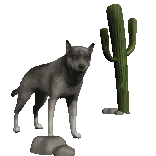
They loaded up their stuff in a covered wagon. When they were crossing the Pecos River, baby Billy fell and the current got him. But Pecos Bill was one resourceful baby, so he settled with a pack of coyotes who raised him.
Pecos Bill was around 15 when one of his brothers found him. This brother had a hard time convincing the kid that he wasn’t a coyote. Billy finally turned around and became a cowhand. However, as long as he lived, he chased lizards and howled at the moon every night. This means he was from Arizona, probably even Tucson itself. Everyone knows all your Arizonans chase lizards and howl at the moon every night.
 Pecos Bill just rode cougars until he came across the only horse that was a match for him. Widow-Maker was one heck of a horse who ate only dynamite. No one could ride him except Pecos Bill.
Pecos Bill just rode cougars until he came across the only horse that was a match for him. Widow-Maker was one heck of a horse who ate only dynamite. No one could ride him except Pecos Bill.
Next Pecos Bill found his lasso.  He never did swing no ordinary rope –no sir! He used a gigantic rattlesnake named Shake.
He never did swing no ordinary rope –no sir! He used a gigantic rattlesnake named Shake.
He and Shake were so good that they once roped an entire herd at one time.
After Pecos Bill tamed Widow-Maker and Shake, he needed another challenge. He waited for the biggest meanest tornado in history to form. This twister was so big
that people on other planets were watching it. Billy reached up to the clouds, grabbed that twister by its tail, and climbed on it. The tornado tried to buck him off, and then it swooped down and drunk up Lake Michigan.
Billy reached up to the clouds, grabbed that twister by its tail, and climbed on it. The tornado tried to buck him off, and then it swooped down and drunk up Lake Michigan.
When they blew over his ranch, Pecos Bill squeezed that twister and made it dump that water on his land, thus saving it from drought. Finally he fell off it, and he hit the ground so hard that the hole he made turned into Death Valley.
Even though he was the most powerful man on earth, Pecos Bill had a heart. One day he was riding Widow-Maker near the Rio Grande when he spotted a cowgirl riding a catfish as big as a whale. He fell madly in love and asked this gal to marry him. Shue-Foot Sue showed up to their wedding in a dress with a big bustle on the back.
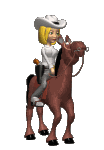 After the wedding, Shue-Foot Sue got the notion to ride Widow-Maker. Pecos Bill was against this it. For one thing, no one but him could ever ride Widow-Maker. For another thing, Widow-Maker was jealous of Shue Foot Sue and hated her guts. But Pecos Bill was so in love, he lost his judgment. Sue only lasted a few seconds on that horse. Widow-Maker bucked so hard that she flew up to the moon. Then she bounced back to earth, and landed on her bustle, which bounced her back up to the moon, where she lives to this day. Pecos Bill tried to lasso her with Shake, but Widow-Maker kept interfering with his throws.
After the wedding, Shue-Foot Sue got the notion to ride Widow-Maker. Pecos Bill was against this it. For one thing, no one but him could ever ride Widow-Maker. For another thing, Widow-Maker was jealous of Shue Foot Sue and hated her guts. But Pecos Bill was so in love, he lost his judgment. Sue only lasted a few seconds on that horse. Widow-Maker bucked so hard that she flew up to the moon. Then she bounced back to earth, and landed on her bustle, which bounced her back up to the moon, where she lives to this day. Pecos Bill tried to lasso her with Shake, but Widow-Maker kept interfering with his throws.

Pecos Bill married many other times, but Slue Foot Sue was always the Love of His Life.
Pecos Bill lived over 150 years until one terrible day when this city slicker from New York City came to town. This Tenderfoot wanted to cowboy, so he bought himself Steve Madden boots, Kim Kardashian jeans, and a Ralph Lauren cowboy shirt. When he came out of the store, Pecos Bill took one look and laughed himself to death. And that’s the sad truth, partner.



For more true-life Arizona legends, see How to Resuscitate a Lizard, Grifting Along with the Tumbling Tumbleweed, and Jackalopes and Sand Sharks. By the way, true story! — someone did resuscitate a drowning lizard. Click on Drowning Lizard gets CPR. This website is happy to provide these public services.
Tags: Jane St. Clair


